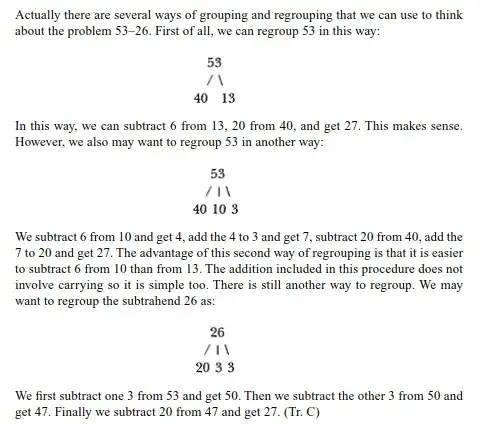(This is not meant to answer why it works formally, because this already been done, but rather a tentative to dwell in the girl's mind.)
I was trying to put me in your daughter's shoes and wondering what could be the mental process going through her mind.
Since she always places the greater number as the subtrahend and the smaller one as the minuend when computing the subtractions it is not reasonable to think that she discovered the concept of a negative number.
Instead of that, it seems that she intuitevely understood the following two things:
A two-digit number is just the sum of the number formed by the "tens digit" followed by $0$ with the "unit digit". (For example, $47 = 40 + 7$.)
The way we count actually orders the numbers, that is, she can tell that a number $n_1$ comes first than another number $n_2$ by counting from $1$ to the latter, $n_2$. For example, if she wants to know if $3$ comes first than $7$, she (mentally) counts
$$ 1, 2, \color{red} 3, 4, 5, 6, \color{red} 7 $$
and so if she (mentally) said $3$ before $7$, then $3$ comes before $7$; or mathematically $3 < 7$. Also she understands that $0$ comes before every "counting number".
Furthermore she may have mastered the skill of computing subtractions with the non-negative integers less than $10$, namely $\{0,1,2,3,4,5,6,7,8,9\}$, when the subtrahend is greater than the minuend. (This because she has only been taught doing this way and also one-digit subtractions are teached first).
So what she found is a pattern to find an easier and equivalent difference of two-digits numbers to a harder difference of two-digits numbers through her grasp of one-digit numbers subtraction.
This is enough to explain her mental process. Let's take your example: $61-17$. This difference of two-digit numbers is harder to do than the one she found using her method. Using her method she obtains an equivalent and easier difference that is $50-6$, a difference of a two-digit number and a one-digit number.
The thing is that her method always reduce the a difference of two-digit numbers to a difference or a sum of a two-digit number and an one-digit number.
But how does she knows when its a sum or a subtraction? For that she compares the unit digit of the subtrahend with the unit digit of the minuend. If the former is greater or equal the latter, then it is a sum, else it is a subtraction. Thus your daughter's evaluation of $61-17$ goes something like this in her mind:
Since $1$ comes first than $7$, I subtract the result of $(7-1)$, namely $6$, from the number formed by the result of $(6-1)$, namely $5$, followed by a $0$, that makes $50$. Then I obtain $50 - 6$ which now I can evaluate. It is equal to $44$ and this is the result of $61-17$.
What is amazing, and you really should keep an eye on it, is that this method is applicable to the much more general scenario of integers subtraction, that is, the subtrahend and the minuend have an arbitrary number of digits, including a different number of each other, and the subtrahend may be less than the minuend. This means that your daughter can further develop her method to encompass all the possible cases of integers subtractions as the classes progress with the subtraction content. If this is the case then perhaps you are raising a future mathematician at home. :)
The following is what a systematized and more advanced version of her method could look like. Consider $147 - 76$.
First we make the two numbers have the same quantity of digits: $147 - 076$.
Now we respectively compare digit to digit and add to the total if the subtrahend digit is greater of equal to the minuend digit or subtract otherwise.
Since $7 \ge 6$ we add $7-6 = 1$ to the total.
Since $4 < 7$ we subtract the number formed by $7-4 = 3$ followed by one zero from the total.
Since $1 \ge 0$ we add the number formed by $1-0 = 1$ followed by two zeros to the total.
Therefore $147 - 76 = 100 - 30 + 1$. (Which is much more easier to compute.)
I have to say that it is very surprising that a third grader could find such a clever pattern. And she does this reasoning at an intuitive level, which only makes it more impressing!
May the gods of mathematics guide your daughter's path!

61 - 20 + 3, as it is equal to61 - (20 - 3). This is a way of having an easier substraction, and an addition which he was compfortable with. While this seems like the easiest way for me, that wasn't the "proper" way he was taught. He ended up frst of his promotion (college). The human brain is an incredible machinery; sometimes, what we think is the best way is only applicable for ourselves. I believe you should support her idea. – Turtle Feb 28 '18 at 15:02